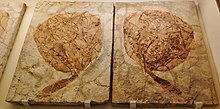Arechia
| Arechia Temporal range: Potential Rupelian occurrence | |
|---|---|

| |
| A. crassicaudata specimen, Museo di Storia Naturale di Verona | |
| Scientific classification | |
| Domain: | Eukaryota |
| Kingdom: | Animalia |
| Phylum: | Chordata |
| Class: | Chondrichthyes |
| Subclass: | Elasmobranchii |
| Order: | Myliobatiformes |
| Family: | Urolophidae |
| Genus: | †Arechia Cappetta, 1983 |
| Type species | |
| Arechia arambourgi Cappetta, 1983 | |
| Other species[1] | |
| |
Arechia is an extinct genus of stingaree from the Paleogene epoch. It is known from two species (one known from articulated remains, the other from isolated teeth) that inhabited the northern Tethys Ocean during the Early Eocene.[2][3] Isolated teeth of this genus are also known, potentially as late as the Early Oligocene.[4]
Taxonomy
It is the oldest known stingaree genus, though molecular data suggests they diverged from butterfly rays about 75 million years ago or from deepwater stingrays around the time of the K-Pg transition.
The type species, A. arambourgi Cappetta, 1983, is known from isolated teeth found in the Ypresian deposits of Ouled Abdoun, Morocco. It is named for Camille Arambourg, who originally ascribed these teeth to Raja praealba in 1952. Henri Cappetta revised the species in 1983, erecting this genus for those Arambourg called males in this genus and placed the ones he called females in Merabatis. [5]
The second species, A. crassicaudata (de Blainville, 1818) is from the Ypresian-age Bolca Lagerstätte of Italy and is known from several articulated individuals. This species was placed in various genera, generally in Urolophus, until finally being attributed to Arechia in 2020, due to the close resemblance of its teeth to those of A. arambourgi. The inferred environment of the Monte Postale site where this species is found matches with the typical warm, shallow environment of extant representatives of this family.[5][6] The bizarre Lessiniabatis was initially thought to represent a partial specimen of this species.[7]
In addition to these two species, isolated teeth of Arechia sp. are known from several sites throughout North Africa, including from the Ypresian & Lutetian of Senegal, Bartonian of Tunisia, and potentially the Rupelian of Egypt.[4][8]
References
- ^ Arechia in the Paleobiology Database
- ^ Arechia arambourgi in the Paleobiology Database
- ^ "Extinct - valid species | Species | Shark-References". shark-references.com. Retrieved 2025-01-25.
- ^ a b Adnet, Sylvain; Marivaux, Laurent; Cappetta, Henri; Charruault, Anne-Lise; Mabrouk, Essid El; Jiquel, Suzanne; Ammar, Hayet Khayati; Marandat, Bernard; Marzougui, Wissem; Merzeraud, Gilles; Temani, Rim; Monique, Vianey-Liaud; Tabuce, Rodolphe (2020). "Diversity and renewal of tropical elasmobranchs around the Middle Eocene Climatic Optimum (MECO) in North Africa: New data from the lagoonal deposits of Djebel el Kébar, Central Tunisia". Palaeontologia Electronica. 23 (2): a38. doi:10.26879/1085.
- ^ a b Marramà, Giuseppe; Carnevale, Giorgio; Naylor, Gavin J. P.; Kriwet, Jürgen (2020-07-03). "Skeletal Anatomy, Phylogenetic Relationships, and Paleoecology of the Eocene Urolophid Stingray Arechia Crassicaudata (Blainville, 1818) from Monte Postale (Bolca Lagerstätte, Italy)". Journal of Vertebrate Paleontology. 40 (4): e1803339. Bibcode:2020JVPal..40E3339M. doi:10.1080/02724634.2020.1803339. ISSN 0272-4634.
- ^ Marramà, Giuseppe; Carnevale, Giorgio; Kriwet, Jürgen (2021). "Diversity, palaeoecology and palaeoenvironmental significance of the Eocene chondrichthyan assemblages of the Bolca Lagerstätte, Italy". Lethaia. 54 (5): 736–751. Bibcode:2021Letha..54..736M. doi:10.1111/let.12436. ISSN 0024-1164. PMC 9291491. PMID 35873368.
- ^ Marramà, Giuseppe; Carnevale, Giorgio; Giusberti, Luca; Naylor, Gavin J. P.; Kriwet, Jürgen (2019-10-01). "A bizarre Eocene dasyatoid batomorph (Elasmobranchii, Myliobatiformes) from the Bolca Lagerstätte (Italy) reveals a new, extinct body plan for stingrays". Scientific Reports. 9 (1): 14087. Bibcode:2019NatSR...914087M. doi:10.1038/s41598-019-50544-y. ISSN 2045-2322. PMC 6773687. PMID 31575915.
- ^ Sambou, Bernard Siguendibo; Sarr, Raphaël; Hautier, Lionel; Cappetta, Henri; Adnet, Sylvain (2017-02-01). "The selachian fauna (sharks and rays) of the phosphate series of Ndendouri-Ouali Diala (Matam, Western Senegal): Dating and paleoenvironmental interests". Neues Jahrbuch für Geologie und Paläontologie - Abhandlungen. 283 (2): 205–219. doi:10.1127/njgpa/2017/0637. ISSN 0077-7749.
